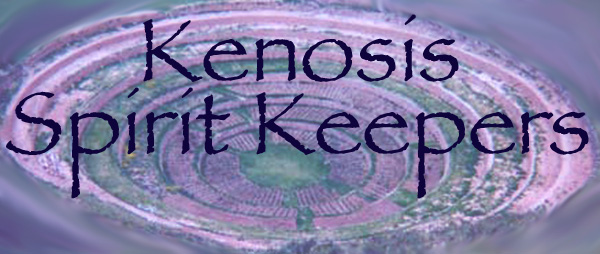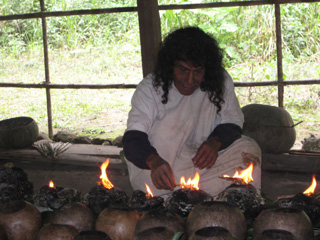
Home | Who We Are | What We Support | Library | Events | Donations | Store
The Seeds of Compassion:
The Transmission of Spiritual Strength from a Hopi Elder to His Lacand—n Maya Brother
Carla Woody
We were gathered in the silversmithing studio of Gerald Lomaventema on Second Mesa. Gerald creates exquisite traditional Hopi jewelry and has won numerous honors, including the prestige of having a one-of-a-kind piece placed on permanent exhibit at the National Museum of Ethnology in Osaka, Japan.
In a separate effort, Gerald, Japanese organizer Atsunori Ito, and Zuni artist Tony Eriacho, Jr. came together to found the Hopi-Zuni Show in Japan, held annually since 2007, and have been working to protect the authenticity of Hopi and Zuni art. It's become so popular in Japan that the inevitable copies are being widely produced with the claim they're Native-made.
At home on Second Mesa, the Hopi Senom Artists are forming for much the same reason — to protect traditions and ensure the development of their community.* I was invited to be an advisor and had come for that purpose. Artist Alan Staiger accompanied me and would later give a photography workshop to the core group of Hopi artists present that day so they could document their art to best advantage.
Sitting in circle, we were discussing the group's intent and some practical aspects of evolving their purpose when the conversation shifted slightly. Hopi elder Harold Joseph commended those present for wanting to benefit their community as a whole, the meaning of larger connection.**
And then he began to tell a story. He spoke in Hopi, in a voice of the same lyrical resonance that drew me into his prayers during times he has traveled with us. He punctuated his tale with English words now and then. As they listened, the artists, too, became absorbed. Expressions became serious and then light, heads were shaking or nodding depending on what Harold was imparting. Periodically Harold looked over at me and we shared an understanding. You see, I didn't have to comprehend the Hopi language. I knew the story he was telling and could testify to its far-reaching importance.

Don Antonio lighting the godpots
Photo credit: Carla Woody
In January 2009, Harold went with us to the village of Naj‡ located in the Lacand—n jungle of Chiapas, Mexico near Guatemala. Sent as an emissary by his religious leader to share traditions, he was also given the instruction to come home and report what he'd seen. To prepare Harold, I'd told him how decimated the ancient Lacand—n Maya traditions had become, with elder Don Antonio Martinez carrying on the sacred ceremonies nearly alone, only a few young men periodically present. At that time, there were no apprentices who had stepped forward; and from Don Antonio's own lips issued the sad words that it was hopeless. No one cared. Too many outside influences pulling the young people away and outside Western-based religions convincing the villagers the old ways were evil. Soon the ancient spirit-keeping beliefs and practices of the Lacandones — those of inclusion and respect for the Earth — would go the way of countless other such Indigenous religions and disappear into the mists of time.
But I had hope. I had a strong sense that if we could bring outsiders to be with Don Antonio — in respectful tribute — to partake in ceremony, to hear the stories, to just sit and be fully present to the beauty offered, then just maybe the village young people would recognize the important foundation their birth tradition gave them. And this would be an act of, what in the Andes they call, ayni, a sacred reciprocity.
One of my readers recently contacted me — in his message describing this opportunity as a "field trip." I wrote back relaying my agreement. For me, his words brought to mind Rumi and his invitation: Out beyond ideas of wrongdoing and rightdoing there is a field. I'll meet you there... That's the way when we enter such a sacred space. Respect, acceptance and support. And in the more traditional meaning of "field trip" it's a sojourn we take to bring home an experience or knowledge that can radically inform our lives, a distinctively positive influence.
By bringing Indigenous people together who have common roots, there's intent that such sharing will enter another level altogether, one of great healing. But there was no way of knowing ahead of time. And we had no inkling of the devastating situation that would greet us when we arrived that year. One of Don Antonio's sons had just died suddenly. The pressure for him to abandon the traditions was intense, applied consistently by the members of the new religious sect in the village. But Harold's presence and support to Don Antonio those few days we were there, bringing his own traditional prayers to merge with Don Antonio's; offering the Hopi creation stories so like those of the Lacondones; speaking about the plight of his own people, so that by the time we left there was a glimmer of expectancy. One that had touched all of us present. In A Humble Connection, I wrote in depth about that time in Naj‡.

After the balchŽ ceremony
Photo credit: Alonso Mendez
The effect of that short time, those moments of compassion and quiet camaraderie, would be revealed over the next year. In March 2009, I received news through my friend Alonso Mendez. During a village gathering in Naj‡, Don Antonio stood and made a public announcement confirming his traditional religion saying he would continue the sacred practices. Shortly after that, Don Antonio formally entrusted the caretaking of his godhouse to his son-in-law Chan K'in.
Both these incidents are quite significant. Just prior to our arrival in January 2009, with pressure mounting for him to discard his faith in favor of the new one, Don Antonio was wavering. While we were there, he had lamented its demise while grieving for his son at the same time. It was heart-wrenching. Harold had entreated, "You must hold on."
It appears that Harold's words found a resting place and Don Antonio strengthened. Turning over the care of his godhouse to Chan K'in signaled apprenticeship and continuity — the same as Chan K'in Viejo passed the ways on to his son-in-law Don Antonio from the time he'd been a young man.
With this news I began to prepare for our next journey to further these connections. Once again chosen by his religious leader on Shungopovi, Harold was to return, and this time, Gerald Lomaventema and Augustine Mowa would accompany him. In January 2010, this small group of Hopi Spirit Keepers and other travelers supporting this work arrived once again in Naj‡.

Lacand—n boy during ceremony
Photo credit: Carla Woody
This time was radically different. A good number gathered for the balchŽ ceremony, too many to fit comfortably in the godhouse, and the atmosphere was light in a way I had never witnessed. There were lots of smiles and laughter. Don Antonio was visibly shining. Aside from the traditional chanting and prayers, music was played. And, for the first time in my experience, a very young Lacand—n boy was there participating with the others. The gods displayed happiness. Their godpots blazed, none of them exhibiting shyness by refusing to light. The perfume of copal filled the air.
Back on Second Mesa, all these months later, we discussed our return to Naj‡ in January 2011, the intent to continue the connection and mutual support. It's about community and seeking strength to hold the integrity of heritage whether its folkart, language, right livelihood, traditional religion and cultural practices — those things that nurture the soul and hold the world together. Through such interaction, any of us are taught to protect and retain what is of value to us — to disallow attempts by others to pluck away pieces of ourselves.
"There was much depth that day," Harold ended his recounting. He sat silent for a few moments, lost in reverie. We all did.
*****************
*Senom is a Hopi word meaning "people."
** Harold and Charlene Joseph appear in our documentary One World Wisdom and will be featured in our Spirit Keepers Series on November 6-7, 2010. Both are on the advisory board for Kenosis Spirit Keepers.
For a related article see Inclusion.
© 2010 Carla Woody. All rights reserved.
Home | Who We Are | What We Support | Library | Events | Donations | Store
Last updated 5 August 2010 | © 2010 Carla Woody